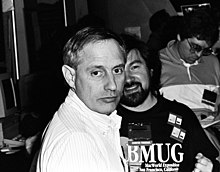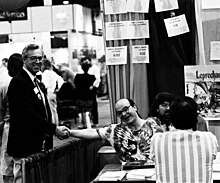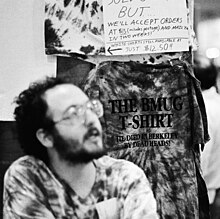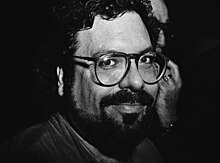Berkeley Macintosh Users Group

The Berkeley Macintosh Users Group, or more commonly "BMUG", was the largest Macintosh User Group. It was founded in September 1984 by a group of UC Berkeley students including Reese Jones[1] and Raines Cohen[2] as a focal-point for the nascent Apple Macintosh user community. With more than 13,000 members, or "BMUGgers" at its peak in 1993, the group was the largest,[3] and generally understood to be the most important,[4] Macintosh users group. A few of the notable members include John "Captain Crunch" Draper, the Sultan of Brunei Hassanal Bolkiah, notorious murderer Enrique Zambrano,[5][6] early hacker-chaser Cliff Stoll, Inktomi founder Eric Brewer, and may prominent computing journalists like John Dvorak,[7] Ilene Hoffman, Leo Laporte and Adam Engst. An example of the group's omnipresent blue-floppy-disk lapel pin is held in the Smithsonian Institution's American History collection.[8] BMUG's history and activities were closely linked with the MacWorld Expo meetings, traditionally held in San Francisco each January and Boston each August.
Organization
Day-to-day management of the organization was balanced between the senior full-time staff: business manager Harry Critchfield, technical manager Steve Costa, and support manager Randy Simon.
Business


BMUG's finances and business operations were managed by Harry Critchfield and Alisa Schulman, better known for her role as a DJ at KALX.[9] In 1995 Anne Wrixon replaced Harry Critchfield,[10] and in 1997, Wrixon was replaced by Hal Gibson, who remained until the end.[11]
Technical


One of BMUG's principal operations was collaborative Macintosh repair and maintenance. A benefit of BMUG membership was hardware repair (and often recovery of lost documents from floppy and hard disks). The technical operations were managed by Steve Costa. Electrical engineer Chuck Meyer conducted many of the trickier repairs. Herb Dang was a fixture in BMUG's technical services, and his son Frank continued that tradition into a second generation.[12]
Support


BMUG maintained a Macintosh support call-center, which helped users around the world by answering questions and helping them resolve technical problems with their computers. The support operation was managed by Randy Simon, and staffed by volunteers.[13] While much of the support operation dealt with assisting users whose computers had crashed, a significant portion of it dealt with the specific "vertical market" of desktop publishing and prepress issues, which was then in its infancy and was one of the Macintosh's primary markets. Randy Simon also coordinated the production and publications of BMUG's massive biannual newsletters, sometimes totaling more than a thousand pages per year, initially with the assistance of BMUG volunteers Carolyn Sagami, Zig Zichterman,[14] Robert Lettieri and Bill Woodcock, and later Hans Hansen. A collaboration between BMUG members, Programming SIG chair Greg Dow (now at Adobe) and networking and prepress expert Bill Woodcock (now at Packet Clearing House) resulted in the first example of "database publishing," a 1989 encyclopedia of Macintosh software, for which plates were produced directly from a FileMaker database without intervening processing.[15][16]
Offices


BMUG was initially located in suite 3B, 2150 Kittredge Street, in downtown Berkeley, directly adjoining the southwest corner of the UC Berkeley campus. This building also housed Farallon Computing until Farallon outgrew the space and moved five blocks south-east to Dwight Way. After six years, BMUG moved to a larger space with street frontage at 2055 Center Street, a block and a half west of campus and directly across from the downtown Berkeley BART station.
Projects
Shareware disk duplication


BMUG's primary revenue-generating activity was the sneakernet distribution of Macintosh shareware software from its comprehensive library on 400k and 800k 3.5" floppy disks.[17][18] BMUG's shareware disk duplication and distribution program was run by Art Lau and Gerald Raddatz, supplemented by the efforts of many of the other volunteers.
BMUGnet/PhoneNET

One of the early successes for the group was BMUGNet, a variant of Apple's LocalTalk system which used standard telephone wires to connect Macintosh computers together in a local area network.[19] Wiring plans were initially published in the Fall 1985 BMUG Newsletter, but members could purchase adapters assembled by the group. Co-founder Reese Jones branched the production off as the commercial business Farallon Computing in 1986, renaming the product PhoneNet.[20] The group invented other subsequent low-cost hardware kits as well... the 1991 introduction of the low-cost Mac LC prompted BMUG to begin offering a $12 VGA monitor adapter.[21] MacRecorder, the first audio input device for the Macintosh, was also first released in 1985 as a BMUG kit, before being productized by Farallon and then Macromedia.[22]
Weekly meetings
BMUG was famous for lively meetings, "We are in the business of giving away information" motto, "BMUG Awards", its great MacWorld Expo get-togethers, CD and book publishing, 400+ page biannual "newsletters" akin to the Whole Earth Catalog, and one of the largest shareware collections for Macintosh Public domain software sold to members and customers on floppy disks. These meetings are often cited by tech notables as their introduction to technology.[23]
BMUG hosted an enthusiastic weekly Thursday night meeting with questions and answers, and software demonstrations by vendors, followed at the end by a raffle. Notable speakers included: Steve Jobs, Guy Kawasaki, Ted Nelson, Heidi Roizen, Andy Hertzfeld, Bill Atkinson, Jean-Louis Gassée, Marc Benioff, Melinda Ann French (Gates) and Bill Gates.
Special Interest Groups

It also held Special Interest Groups (SIGs) on Basic Mac, Troubleshooting, ClarisWorks (integrated word processing, drawing, painting, spreadsheet, database and telecommunications), FileMakerPro relational databases, graphics, video, music, the Internet, programming and mathematics. Branch groups held general meetings in outlying areas, including San Francisco, Cupertino and Tokyo.
Biannual Newsletter
Rather than publish a standard monthly newsletter, the group decided to publish a collection of articles in a bound book every six months. The resulting "newsletter" routinely exceeded 300 pages in length. The newsletter was originally edited by volunteers Carolyn Sagami and Zig Zichterman, until Randy Simon was hired as staff, and then turned over to Hans Hansen when Randy departed. [24]
Bulletin Board System

BMUG's Bulletin board system or "BBS" was managed by Bernard Aboba (then in graduate school at Stanford and UC Berkeley, subsequently at Microsoft) with the assistance of Bill Woodcock. It was an early FidoNet node, and from 1986 through 1993, the home of the FidoNet MacNetAdmin "echo," which spawned the AppleTalk Network Managers Association (which in turn begat the AppleTalk Networking Forum), the inaptly-named A/UX Users Group, and numerous other real-world periodic meet-ups. The BMUG BBS also served as a nexus for the interoperability testing of email gateways between FidoNet, UUCP, SMTP, and a number of proprietary AppleTalk, NetWare, and Internet Protocol electronic mail systems, including CE Software's QuickMail,[25] SoftArc's FirstClass,[26] those from Information Electronics[27] and AppleLink Personal Edition, which went on to become America Online. When the BBS host system in Berkeley was damaged by the 1989 Loma Prieta earthquake, Aboba set up a temporary stand-in using a solid-state industrial PLC and multi-line serial controller, which was able to keep up with the heavy call volume by answering, presenting an ASCII banner explaining the situation, and immediately disconnecting. The BBS eventually ran on hardware in Berkeley, Palo Alto, Boston, and Tokyo.
Books
In addition to the newsletter, BMUG published the occasional reference book. These included:
- The BMUG Guide to Bulletin Boards and Beyond, by Bernard Aboba, 1992 - A guide to setup and management of dial-up BBSs.[28][29]
- Zen and the Art of Resource Editing, by Derrick Schneider, 1990-1995 - A guide to using Apple's ResEdit tool to modify Macintosh software.[30]
- The Tao of AppleScript, by Derrick Schneider, 1993 and 1994 - A guide to scripting and automation under MacOS System 7.[31]
Controversy
Rivalry with the Boston Computer Society
BMUG was certainly the largest Macintosh users group,[32] but the Boston Computer Society was the largest computer users group. BCS-Mac, the Macintosh special interest group of the Boston Computer Society, was the second largest Macintosh users group. A good-humored rivalry obtained between the two groups throughout their mutual existence, but they were ultimately supportive of each other.[33] BMUG's first foray onto BCS-Mac's Boston home turf, at MacWorld Expo on August 11–13 of 1987 was commemorated with a new T-shirt, featuring an inscription "BMUG in Boston" which Bill Woodcock, who designed BMUG's T-shirts, intended to look like graffiti, using a rattle-can to write the original text in black paint on white paper, which was then photographed, scanned, and converted to PostScript in Adobe illustrator, before being silkscreened in red on black shirts. The red-on-black effect, however, was said by startled BCS-Mac members to more resemble dripping blood than spray-paint.
1995-1997 Budget Crisis
By 1995, BMUG had accumulated a debt of $250,000, which forced a two-year period of restructuring and the layoff of some of the staff, but which was weathered successfully.[34][35]
Closure and Legacy





With the increasing cost of printing the biannual newsletter, decreasing membership and the waning sales of software due to the rise of the Internet, revenues could not keep up and the not-for-profit corporation declared bankruptcy in 2000. However, its members continued to collaborate and meet as separate entities in the following years.[37][38][39][40]
- the San Francisco branch continued as BMUGWest[41] until their closure in March 2016.[42]
- the South Bay branch continues as Silicon Valley MUG, still active in 2024.[43]
- Members purchased the group's online presence (the BMUG BBS) and kept it running as PlanetMUG, in conjunction with The BostonBBS[44] (formerly the Boston Computer Society's Mac BBS), until PlanetMUG shut down in early 2023.[45]
See also
References
- ^ "Strategic News Service - Future in Review 2008 Participants". Archived from the original on 2008-10-19. Retrieved 2009-01-05.
- ^ "2005 SF Mac Expo (Photo story) - Brian Thomas".
- ^ Nakamura, Lisa (2002). Cybertypes: Race, Ethnicity, and Identity on the Internet. Routledge. p. 190.
- ^ Pang, Alex Soojung-Kim (14 July 2000). "User Groups and the Macintosh". Making the Macintosh: Technology and Culture in Silicon Valley. Stanford University.
The most important Macintosh user group in the area, and arguably within the entire user group movement, was BMUG. Started in 1984 by Berkeley students Reese Jones, Raines Cohen, Tom Chavez, and others, BMUG's members went on to found numerous businesses, most notably the networking companies Farallon and Netopia; develop software and hardware for the Macintosh; write for Macintosh industry magazines; and serve as some of the machine's staunchest advocates.
- ^ "Enrique Zambrano". USA Death Row 2019. Retrieved 30 November 2019.
- ^ McCullagh, Declan (10 August 2007). "Death row inmate's fate turns on the word 'hacker'". clnet. Retrieved 29 November 2021.
- ^ "Dvorak's Inside Track to the Mac". Centre for Computing History. Retrieved 30 November 2021.
- ^ "Advertising Button, Berkeley Macintosh Users Group (BMUG)". National Museum of American History. Smithsonian Institution. Retrieved 30 November 2021.
This square button, designed to look like a 3½" floppy diskette, has a blue background. At the top, in a yellow rectangle, is a blue image of a clock tower and blue text that reads: 'BMUG Disk / BMUG / 1442A Walnut St. #62 / Berkeley, CA 94709 / (415) 849 9114.' On the reverse is a black card with a metal pin.
- ^ Schulman, Alisa. "Set List". KALX. UC Berkeley. Retrieved 29 November 2021.
- ^ Richtel, Matt (30 May 1998). "User Group Stands by Its Mac". New York Times. Retrieved 30 November 2021.
- ^ Hu, Jim (7 November 1997). "BMUG plans a comeback". clnet. Retrieved 30 November 2021.
- ^ "Frank Dang Biography". Educause. Educause. Retrieved 30 November 2021.
- ^ Breen, Christopher (30 January 2014). "The Mac at 30: Tales from the Berkeley Mac Users Group". MacWorld. Retrieved 30 November 2021.
Before the Genius Bar and before Apple's own online forums, when the Mac was young and its users needed help, there were user groups: Part social clubs and part volunteer tech-support staffs, they disseminated tips, troubleshooting advice, news, and arguments about the Mac. They distributed loads of early Mac shareware and became important stops for vendors promoting new Mac products (including one Steve Jobs when he was trying to get NeXT Computer off the ground). And in that early Mac age, no user group was bigger or more important than the Berkeley Macintosh Users Group, known to all as BMUG. Founded in 1986 and lasting for 14 contentious years, it at one point reportedly boasted more than 13,000 users, with satellite groups in Boston and Japan.
- ^ "Producing a User Group Newsletter". BMUG. 1988.
- ^ Dow, Gregory H.; Woodcock, Bill (1989). BMUG Disk Catalog 1989. Berkeley: BMUG, Inc. Retrieved 30 November 2021.
- ^ Rowe, Jonathan (25 August 1989). "Business Suits, Briefcases Invade Macintosh Mecca". Christian Science Monitor. Retrieved 30 November 2021.
Consumer groups are trying to fill the void. The Berkeley Macintosh Users Group, BMUG, has 10,000 members, about half in California. Weekly meetings in the Bay Area attract several hundred people. The BMUG booth had an unvarnished hackers' quality that seemed a throwback to Apple's early days. 'We provide technical support to end users that Apple doesn't provide any more,' said Bill Woodcock, a volunteer, who works at Farallon Computing and volunteers two to three hours a day. Dealing with Apple is hard, he says. 'We don't buy thousands of machines every year, and we don't make millions of dollars.'
- ^ Potts, Mark (25 October 1993). "Sharing Shareware's Secrets". Washington Post. Retrieved 30 November 2021.
- ^ Hill, Michael (22 January 1996). "Mac Heads Respond to Article About Buying an Apple". SFGate. Retrieved 30 November 2021.
- ^ Hanss, Ted (14 July 1986). "unknown article title[citation needed]". The University of Michigan Computing News. 1 (1): 15.
- ^ "Recalling the Loma Prieta earthquake and Mac advantages". ZDNet.
- ^ Quinlan, Tom (8 April 1991). "Kit and Connector open LC to VGA". Macintosh News.
For Mac LC owners to want to take advantage of the machine's capability to hook up to a VGA monitor, the Berkeley Macintosh Users Group (BMUG) is shipping an adapter that lets users do just that. Users can purchase the adapter as a parts kit from BMUG for $12 or fully assembled for $39.95.
- ^ Sebelumnya. "SoundEdit". Retrieved 30 November 2021.
SoundEdit was the first popular GUI-based audio editor for digitized audio. It was not only one of the first important audio applications for Macintosh, but one of the first significant audio applications for personal computers in general. SoundEdit was one of three audio applications created during a sabbatical by Steve Capps during 1986. The Macintosh had no built-in sound input, so the MacRecorder audio digitizer was invented for this purpose in 1985 by Michael Lamoureux, a mathematics student at the University of California, Berkeley. The MacRecorder hardware and software was publicly released through the Berkeley Macintosh Users Group as a kit in late 1985. SoundEdit first shipped in January 1988, as part of a hardware product called MacRecorder Sound System, by a company called Farallon Computing (which eventually became Netopia). One of the major drivers for SoundEdit was Apple's HyperCard. With MacRecorder Sound System, stack makers could finally create alternatives to HyperCard's two built-in sounds.
- ^ "The Tech Class of 2011: Meet the Emerging Leaders" (PDF). Politico. Retrieved 30 November 2021.
- ^ Leonard, Peter (21 May 2016). "The first BMUG newsletter". The Goggles Do Nothing.
- ^ Engst, Adam (16 September 1991). "CE Ships QuickMail". TidBITS. Retrieved 29 November 2021.
- ^ Anbinder, Mark (14 November 1994). "TCP/IP FirstClass Ships". TidBITS. Retrieved 29 November 2021.
- ^ Anbinder, Mark (6 July 1992). "A New Direction for IE". TidBITS. Retrieved 29 November 2021.
- ^ Aboba, Bernard (1992). The BMUG Guide to Bulletin Boards and Beyond. Berkeley, California: BMUG, Inc. p. 541. ISBN 9781879791039.
- ^ Branscum, Deborah (April 1993). "Swap Tips around the World". MacWorld.
An excellent, more general guide to Internet, FidoNet, and much more is The BMUG Guide to Bulletin Boards and Beyond by Bernard Aboba, a BMUG sysop and knowledgeable denizen of the online world. (The second edition will be out in March. It should be available from Quantum Books [617/494-5042] in Cambridge, Massachusetts.)
- ^ Schneider, Derrick; Hansen, Hans; Potkin, Noah (1992). Zen and the Art of Resource Editing, Third Edition. Peachpit Press. p. 220. ISBN 0938151754.
- ^ Schneider, Derrick (1994). The Tao of AppleScript, 2nd Edition. Hayden Books. p. 387. ISBN 1568301154.
- ^ Saigh, Robert (1998). The International Dictionary of Data Communications. Chicago: Glenlake Publishing Company. p. 409. ISBN 1-888998-28-8.
BMUG, the Berkeley Macintosh Users Group, is the world's largest advocacy group for Macintosh computer users.
- ^ Hamblen, Matt (23 September 1996). "Help pouring in for BCS". ComputerWorld. Retrieved 30 November 2021.
BMUG is offering BCS members access to its Internet help at both its Berkeley and Boston offices, as well as the biannual 300-page newsletter and help guide, among other services. BCS Interim Executive Director Frank Smith said potentially 7,000 BCS-Mac SIG members will be interested in the BMUG offer.
- ^ "World's Largest Mac User Group: We'll Survive". WIRED. 5 November 1997. Retrieved 30 November 2021.
- ^ Abate, Tom (November 4, 1997). "$150,000 Debt Could Kill Berkeley Mac Users Group". Business. San Francisco Chronicle. pp. C3. Retrieved 16 December 2008.[permanent dead link]
- ^ Abbott, Katy (3 November 2016). "Mayoral candidate Bernt Wahl hopes to bring technological solutions to Berkeley". The Daily Californian. Retrieved 30 November 2021.
- ^ clnet Staff (1 September 2009). "BMUG: the end of an era". clnet. Retrieved 30 November 2021.
- ^ Laporte, Leo (26 January 2009). "BMUG Reunion".
- ^ Benner, Katie (8 September 2015). "Mac User Groups Fade in Number and Influence, but Devotees Press On". New York Times. Retrieved 30 November 2021.
- ^ Cohen, Peter (26 June 2015). "In praise of Mac User Groups". iMore.
- ^ Breen, Christopher. "Tales from the Berkeley Mac Users Group". Macworld. Retrieved 2023-03-28.
- ^ BMUGWest. Archived 2016-03-22.
- ^ "The Silicon Valley Macintosh User Group - General Information". www.svmug.org. Retrieved 2024-11-26.
- ^ "The Boston BBS - A Virtual Harbor in Cyberspace". Retrieved 2004-06-10.
- ^ "Planet Mug – Come for the tech support, stay for the Community". Archived 2023-09-01.
External links
- Virtual Harbor, the successor group to the BMUG BBS / PlanetMUG and its partners
- Silicon Valley Macintosh User Group, the south-bay outgrowth of BMUG, which continues to this day
- Bellarine Mac User Group, unrelated but with the same acronym and purpose, currently operating in Geelong, Australia
- LaserWriter II: A Novel, documenting the contemporaneous and similar community around Tekserve, a similar Macintosh User Group in New York
